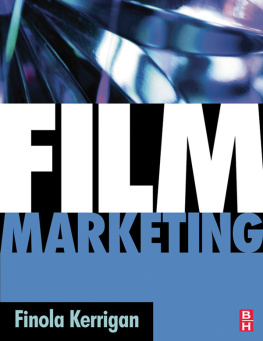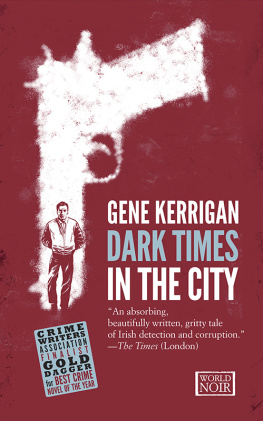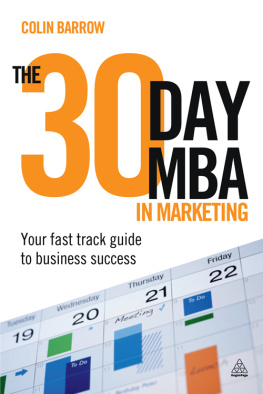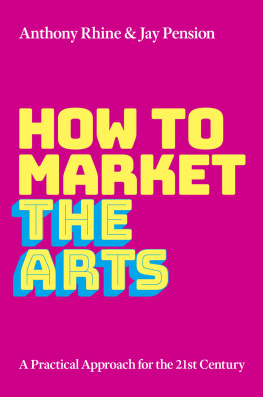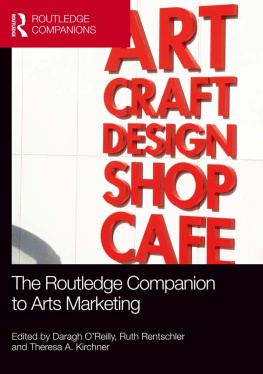Film Marketing
Film Marketing
Finola Kerrigan

Butterworth is an Imprint of Elsevier
Linacre House, Jordan Hill, Oxford OX2 8DP, UK
30 Corporate Drive, Suite 400, Burlington, MA 01803, USA
First edition 2010
Copyright 2010, Finola Kerrigan. Published by Elsevier Ltd. All rights reserved.
The right of Author Name to be identified as the author of this work has been asserted in accordance with the Copyright, Designs and Patents Act 1988
No part of this publication may be reproduced, stored in a retrieval system or transmitted in any form or by any means electronic, mechanical, photocopying, recording or otherwise without the prior written permission of the publisher
Permissions may be sought directly from Elseviers Science & Technology Rights Department in Oxford, UK: phone (+44) (0) 1865 843830; fax (+44) (0) 1865 853333; email: , and selecting Obtaining permission to use Elsevier material
Notice
No responsibility is assumed by the publisher for any injury and/or damage to persons or property as a matter of products liability, negligence or otherwise, or from any use or operation of any methods, products, instructions or ideas contained in the material herein. Because of rapid advances in the medical sciences, in particular, independent verification of diagnoses and drug dosages should be made
British Library Cataloguing in Publication Data
A catalogue record for this book is available from the British Library
Library of Congress Cataloging-in-Publication Data
A catalog record for this book is available from the Library of Congress
ISBN: 978-0-7506-8683-9
For information on all Butterworth-Heinemann publications visit our web site at books.elsevier.com

Contents
Acknowledgements
The road to finishing this book feels like a very long one, and many people have helped in getting me here. It is inevitable that some will be inadvertently excluded from this list. During the writing of this book I was unsure of whether I should thank Anna Fabrizio who first persuaded me to write this book for Elsevier and Francesca Ford who followed her for her continued enthusiasm for the project. Having eventually come to the end of the project I am very grateful to both of them for their encouragement. Thanks are also due to Marie Hooper, Amy Laurens and Sarah Long for their patience and cooperation. I am very grateful to Suja Narayana for meticulously proofreading this manuscript. Particular thanks are due to Sumanta Barua who acted as research assistant in helping to prepare this manuscript. Without Sumantas tireless efforts, this process would have taken even longer and my lack of attention to detail would have gone unchallenged. Thanks are also due to Huda Abuzeid for her help in trying to secure permissions for this book and to Dirk Vom Lehn for providing me with comments.
Thanks are also due to my parents for many things, not least for taking out cinema advertising for their business when I was a teenager and therefore providing me with free weekly access to the delights of the Gaiety Cinema in Sligo. This started me off as a regular film consumer. Back in the late 1980s and early 1990s Sligo did not benefit from a wealth of international cinema, but I did get access to popular US, UK and Irish films. Thanks to my great friends at University College Galway who queued up to watch the film society films and braved the alleged mice to see great International films in the cinemas of Galway. Particular thanks must go to the Tuesday Night Cinema Group although I have become an unreliable member over the past few months in my final dash to the finish with this book.
I have had the pleasure of working with a number of supportive and inspiring colleagues since I first started to take a serious interest in the film industry and film marketing issues and I would like to extend my thanks to Gisela Gauggel-Robinson, Alvaro Mason, Anne Boillot, and other colleagues who encouraged my work and study of the film industry during and after my time at the MEDIA Programme. My doctoral research was generously funded by the University of Hertfordshire Business School and I am very grateful for the support and friendship that I received from colleagues there. I am grateful to my colleagues at Kings College London, past and present for the interesting discussions, feedback on my work and words of encouragement which have created an environment in which I have been able to develop my research.
Over the last decade, I have formally interviewed, informally chatted with and benefitted from the expertise of many film industry professionals. I am very grateful to them all for their time and the insight which they offered me over the course of my study of the film industry. I was particularly fortunate to have the opportunity to participate in the excellent Strategic Film Marketing Workshop during my doctoral study which provided me with invaluable insight into film marketing practice. Thanks are due to Paul Nwulu who helped me navigate my way through the Nigerian film industry.
Finally, I would like to thank Susanna Capon for inviting me to teach film marketing on the MA Film and TV Producing at Royal Holloway and Gillian Gordon for allowing me to continue. I have benefitted greatly from this experience and each one of my students on that course has contributed significantly to my thinking around film marketing. To teach such knowledgeable and talented students has been a privilege.
Sections of chapter two have previously been published in Kerrigan, F. 2004. Marketing in the Film Industry in Kerrigan, F., Fraser, P. and zbilgin, M. (eds.) Arts Marketing, Oxford: Elsevier.
Chapter 1
Introduction
Contents
As the opening scene for this book on film marketing, this chapter will follow the format of all good opening scenes. In doing so, it will introduce the key characters of this book: marketing and the film industry. In positioning this book, as all good marketers should, in film terms it is a cross-over. Although its core audience is quite niche, i.e. students, researchers and academics with an interest in the marketing elements of film, there is a desire for the book to cross-over into other audience groups, those with an interest in film more broadly and marketers from other sectors who are curious about the world of film marketing. For this reason, this chapter will both introduce the layout as well as introduce the readers to the main characters, marketing and the film industry. As volume after volume has already been written about marketing, what it is, what it is not and what it could or should be, I will not rehearse all of these debates. For that reason, readers may well dispute the presentation of marketing within these pages. My presentation of marketing theory is derived from my study of film marketing and from the elements of marketing and wider management theory that I see as helpful in understanding film marketing processes. Like all areas of marketing, film marketing concerns both the production and the consumption of film and this dual focus is present in this book. In this book, film marketing, or the marketing of film is viewed as primarily concerned with how filmmakers and marketers position the film within the minds of consumers in order to encourage consumption of their film. Scholars of audience reception studies, film studies and related areas have studied film consumption from a number of perspectives and this book will refer to these studies, but does not claim to develop theories of audience reception. Rather, the focus on consumers is concerned with how consumers interpret the marketing messages projected by filmmakers and marketers and how this influences selection and enjoyment of film and on recent technological developments which have seen the relationship between filmmakers and consumers of film deepen.
Next page
